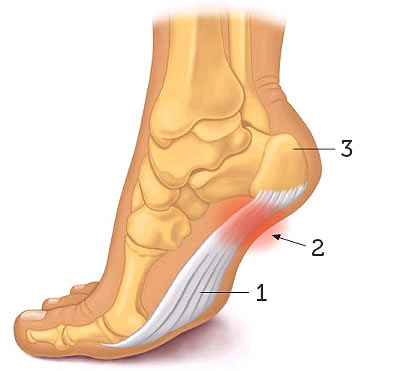
Plantar fasciitis is one of the most common complaints among active individuals. It usually begins as a tenderness or mild discomfort on the sole of the foot, in the heel or arch area. Gradually, as it progresses, it becomes more severe, and localizes usually to a spot under the heel. Most people find the discomfort is worse first thing in the morning or upon getting up after sitting or resting for a while. It often feels better after walking around for a few minutes. It will be painful after running or being very active.
Causes
The plantar fascia is a tough ligament-like band, or sheet, of tissue that runs from your heel, through the arch area and out to the ball of the foot. This band helps try to maintain an arch to the foot. If you have “flat feet”, or if you over-pronate (feet roll in), the plantar fascia becomes strained, with most of the stress occurring at the heel.
Treatment

You either need to reduce the amount of over-pronation, support the arch, or both. Motion-control running shoes with firmer mid-soles can often help. Over-the-counter insoles or orthotics may also provide some relief. Supportive taping by a physical therapist, podiatrist or trainer may provide temporary relief. If the pain persists seek out professional help — the sooner the better. Sometimes physical therapy, massage therapy, anti-inflammatory pills, laser therapy or injections are indicated. Most often though, custom orthotics fabricated by a sports medicine oriented podiatrist are the best long-term solution. The orthotics can be custom made to suit you and your level of activity. If your heel pain continues to be chronic and unresponsive to other conservative measures, you may be a candidate for Extracorporeal Shockwave Therapy. Rarely is surgery indicated.
Prevention
Stretching your calf muscle before and after running or exercising is often helpful. If you over-pronate wear firmer, motion-controlled sneakers.
Activity Restrictions
It depends on the amount of pain or discomfort. Generally, you can run with a mild case of plantar fasciitis.